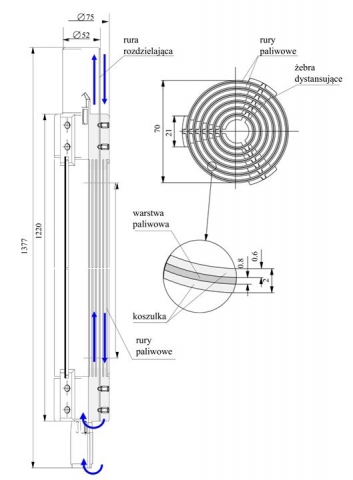Cooling in the MARIA reactor
During a single act of 235U fission, more than 200 MeV of energy is emitted. Part of this energy is carried away by neutrinos, while the rest is emitted in the reactor in the form of heat. More than 80% of the fission energy is the kinetic energy of the fission products, deposited virtually at the point of origin, i.e. in the fuel layer. Hence, the cooling of the fuel itself is particularly important.
In the MARIA reactor, fuel cooling is provided by a pressurised fuel channel cooling circuit.
With an inlet water pressure to the fuel element of 1.7 MPa, an inlet water temperature of up to 50°C and a flow rate of 25 to 30 m3/h, a power output of over 1.8 MW can be extracted from a single fuel element. In comparison, the total heat output of the first Polish research reactor EWA (before modernisation) was 2 MW. Despite such high heat generation, the maximum temperature of the fuel element jacket does not exceed 155°C. This is a much lower temperature than the saturation temperature of water at the prevailing pressure in the fuel channel (over 200°C).
How does the coolant flow in the fuel element?
Cold water flows from the top into the slots between the 3 outer fuel pipes, turns back at the bottom of the element and returns to the top through the water slots between the inner fuel pipes. The middle pipe (traditionally designated as pipe #4) splits the top-to-bottom flow and is an extension of the flow splitting pipe along the entire height of the fuel channel.
The rest of the core is cooled by water flowing from top to bottom through the reactor pool. This is an open (non-pressurised) pool cooling circuit. The heat generated in the non-fuel elements of the core comes mainly from gamma radiation emitted from the fuel, as well as from nuclear reactions occurring in the core materials under the influence of neutron radiation. Much of the heat received by the pool cooling circuit comes from the heat exchange between the fuel channels and the pool.
The two primary cooling circuits of the MARIA reactor (the fuel channel circuit and the pool circuit) dissipate (via heat exchangers) heat to a common secondary circuit, which in turn, via a fan cooler, discharges to the atmosphere.





